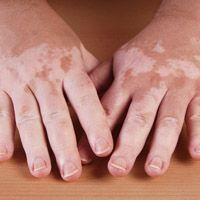News
Article
Global Mental Health Burden for Vitiligo Greatest Among Darker Skin Types, Those with Facial or Hand Lesions
Author(s):
This new data indicates the necessity of health providers around the world to address the mental health needs of vitiligo patients, especially among those most heavily affected.

Patients around the world with vitiligo with the greatest reported mental health burden include those with darker Fitzpatrick skin types, those with over 5% body surface area (BSA), and those with lesions on the face or the hands, according to new findings.1
These findings were yielded from the cross-sectional and population-based study known as Vitiligo and Life Impact Among International Communities (VALIANT), which had collected participants through an online panel from a total of 17 countries across the globe.
The research was conducted to expand upon the existing knowledge of vitiligo burden from patients’ perspective, given that they are more likely to report having depression and anxiety as opposed to those without the skin condition.2 The study was led by Kristen Bibeau, PhD, MSPH, from the Incyte Corporation in Wilmington, Delaware.
“Here we explore sociodemographic characteristics and QOL and describe differences in psychosocial burden across geographic regions and subgroups of disease characteristics among patients surveyed in the Vitiligo and Life Impact Among International Communities (VALIANT) study,” Bibeau and colleagues wrote.
Background and Findings
The investigators carried out their research between May and June of 2021, using a cross-sectional and observational, qualitative approach to the design. The team utilized adult participants in the age range of 18 years or older, with those involved having been diagnosed with vitiligo by healthcare professionals.
The research team had included participants from an online panel drawing from a total of 17 nations around the world, utilizing a general population sampling strategy. Prior to their 25-minute survey, the study’s participants were asked to initially fill out an online screener.
The investigators noted that the main goal of their survey was to assess the self-reported emotional well-being of patients, determine their quality of life (QOL), and explore the existence of depressive symptoms among the target sample of about 3500 participants. Their additional tools for assessment included the Patient Health Questionnaire—9 screener for depression as well as the Vitiligo Impact Patient scale (VIPs).
Comparisons were conducted by the investigators to assess the data from the various countries, 7 specific types of geographic regions, and different types of demographic and clinical subgroups in the study. The team compared the mean values through the use of t-tests, and categorical counts were conducted by the team through χ2 testing.
The investigators determined that they would establish statistical significance at a threshold of P < .05 (2-sided). Their assessment of the data was done by utilizing WinCross, version 20, software.
The research team ended up with 3541 participants, and the participants had a median age of 38 years, with 54.6% being male patients. Around 45.2% were shown to have over 5% affected BSA as a result of vitiligo, and 40.8% were found to have darker skin with Fitzpatrick skin types IV - VI.
The team noted that the global short-form VIPs score had an average of 27.3 overall, and that the highest scores were reported by Indian participants at 40.2. Those with over 5% affected BSA, darker skin types, or lesions on their face or hands were shown to have experienced profound QOL burdens, with scores of 32.6 , 31.2, 30.0, and 29.2, respectively.
The investigators added that 55.2% of the study’s participants expressed vitiligo's impact on their daily lives, especially in choices of clothes. They added that 59.4% of them frequently had to conceal their skin disease. About 58.7% reported diagnoses of mental health issues, including anxiety at 28.8% and depression at 24.5%.
The team reported that the Patient Health Questionnaire–9 indicated that there were depressive symptoms in 55.0% of the participants, with the highest rates being in India among 89.4% and the rates being highest among those with darker skin (68.3%) and with more than 5% affected BSA (72.0%).
“Findings highlight the need to prioritize reduction in the psychosocial burden of vitiligo and increase efforts to educate patients and health care professionals on vitiligo, particularly in countries where patients experience the highest burden,” they wrote.
References
- Bibeau K, Ezzedine K, Harris JE, et al. Mental Health and Psychosocial Quality-of-Life Burden Among Patients With Vitiligo: Findings From the Global VALIANT Study. JAMA Dermatol. Published online August 30, 2023. doi:10.1001/jamadermatol.2023.2787.
- Wang G, Qiu D, Yang H, Liu W. The prevalence and odds of depression in patients with vitiligo: a meta-analysis. J Eur Acad Dermatol Venereol. 2018;32(8):1343-1351. doi:10.1111/jdv.14739.





